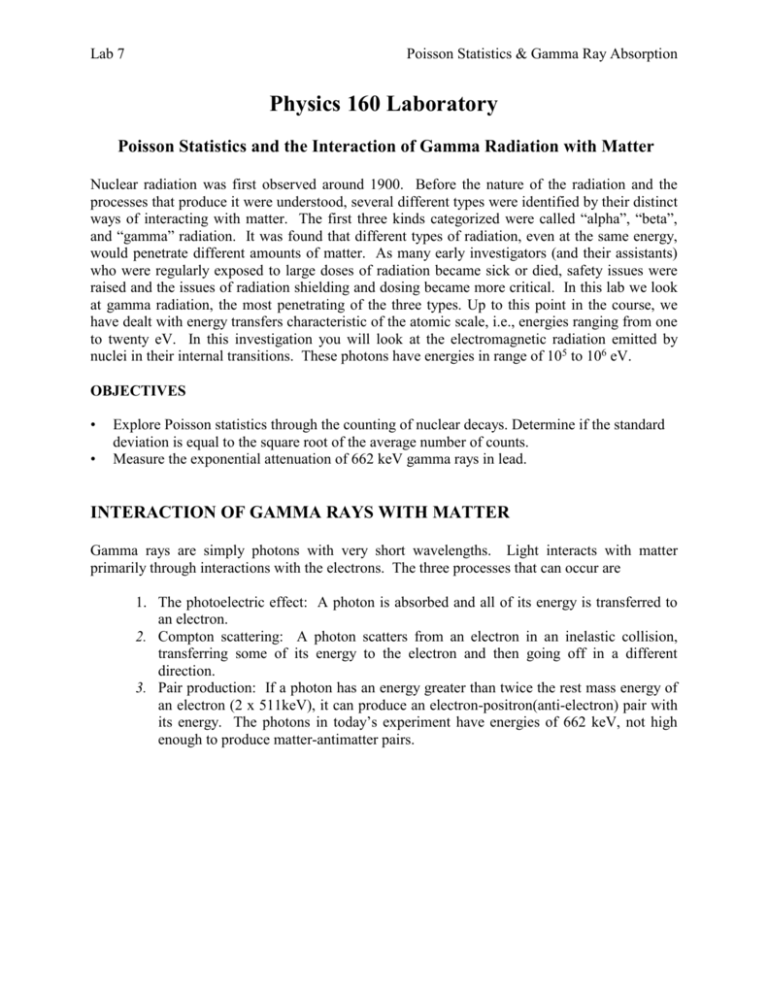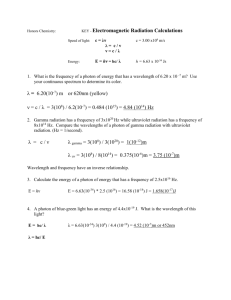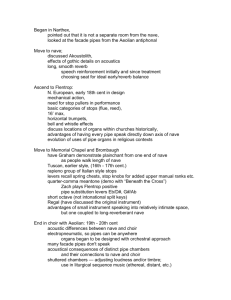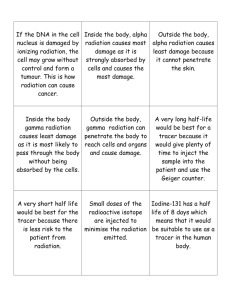RadCount - Lawrence University
advertisement

Lab 7 Poisson Statistics & Gamma Ray Absorption Physics 160 Laboratory Poisson Statistics and the Interaction of Gamma Radiation with Matter Nuclear radiation was first observed around 1900. Before the nature of the radiation and the processes that produce it were understood, several different types were identified by their distinct ways of interacting with matter. The first three kinds categorized were called “alpha”, “beta”, and “gamma” radiation. It was found that different types of radiation, even at the same energy, would penetrate different amounts of matter. As many early investigators (and their assistants) who were regularly exposed to large doses of radiation became sick or died, safety issues were raised and the issues of radiation shielding and dosing became more critical. In this lab we look at gamma radiation, the most penetrating of the three types. Up to this point in the course, we have dealt with energy transfers characteristic of the atomic scale, i.e., energies ranging from one to twenty eV. In this investigation you will look at the electromagnetic radiation emitted by nuclei in their internal transitions. These photons have energies in range of 105 to 106 eV. OBJECTIVES • • Explore Poisson statistics through the counting of nuclear decays. Determine if the standard deviation is equal to the square root of the average number of counts. Measure the exponential attenuation of 662 keV gamma rays in lead. INTERACTION OF GAMMA RAYS WITH MATTER Gamma rays are simply photons with very short wavelengths. Light interacts with matter primarily through interactions with the electrons. The three processes that can occur are 1. The photoelectric effect: A photon is absorbed and all of its energy is transferred to an electron. 2. Compton scattering: A photon scatters from an electron in an inelastic collision, transferring some of its energy to the electron and then going off in a different direction. 3. Pair production: If a photon has an energy greater than twice the rest mass energy of an electron (2 x 511keV), it can produce an electron-positron(anti-electron) pair with its energy. The photons in today’s experiment have energies of 662 keV, not high enough to produce matter-antimatter pairs. The interaction processes ultimately result in the total conversion of the photon’s energy to other forms. The intensity of a gamma ray beam then decays with the distance traveled through a medium according to the relation: I I 0 e kx , where k is the attenuation coefficient. The units of k are inverse length. The inverse of k is l 1 k , the mean free path traveled by a photon. This is the average distance traveled by a photon before interacting with an electron. It depends on the energy of the photon and the density of the material that is passes through. The figure to the right shows the contributions of the three processes in a NaI crystal. The lower graph shows the transmission of gamma rays through lead for energies of 200 keV, 400 keV, and 1000 keV. You will be making measurements at 662 keV Poisson Statistics Nuclear decays are an example of a stochastic (random) process that occurs at a well defined average rate. There is a constant probability per unit time that any individual excited nucleus will decay and emit a gamma ray. That probability does not depend on what any other nucleus is doing or on how long the excited nucleus has survived so far. If the average number of decays in a given time interval is N, the number that an experimenter will measure in that time interval will fluctuate with the probability of getting n counts given by the Poisson probability distribution, N neN P(n, N ) . The standard deviation of this probability distribution is N . As N n! grows, this distribution rapidly approaches the Gaussian or normal distribution with mean value N and standard deviation N , P(n) 1 n N 2 e 2 N . As a result, whenever data result 2N from the counting of random events an uncertainty of N is attached to a count value of N. Equipment For this experiment you will be using a Geiger-Müller tube connected to a pulse counter (or scaler). A Geiger-Müller (GM) tube is a cylindrical capacitor consisting of a middle wire held at a positive potential and an outer cylinder held at ground potential. The potential difference should be preset to about 900 V. The GM tube is filled with a gas that is ionized when radiation passes through the tube. The electrons from these ions are so rapidly accelerated toward the positive wire they also ionize the gas in their path resulting in a large pulse of current. The positive ions drift to the outer cylinder to complete the circuit and are de-ionized by acquiring electrons from the cylinder wall. The counter adds one to its total for each pulse and reports the final number. We will use the computer program ST350 (under Spectrum Technologies) to control the counter. This software is very flexible and allows you to set such things as the counting time and the total number of runs to do. It also records the results in a table that can be saved to disk and read by EXCEL. Nuclear Counting Statistics First, explore the ST350 controls. The program is intuitive, so it should not take you long to get used to it. You may want to try to: Set the high voltage on the GM tube to 900V. (This is a good operating voltage for these tubes. For consistency, make sure all your data are taken at the same voltage.) Place the radioactive Cs-137 source on a shelf below the counter where it produces approximately 15 counts per second. Set up the program to count for one thousand-one second intervals with no intervening delay. Transfer your data to EXCEL and calculate the average Nave, the standard deviation of the universe , and the square root of Nave. In theory, the larger Nave is, the closer Nave is to . (Do your results corroborate this?) Use the max and min functions in EXCEL to find the range of outcomes from this set of identically conducted measurements. Analysis: Transfer your data to EXCEL and calculate the average Nave, the standard deviation of the universe , and the square root of Nave. In theory, the larger Nave is, the closer Nave is to . (Do your results corroborate this?) Use the max and min functions in EXCEL to find the range of outcomes from this set of identically conducted measurements. Use the frequency function in EXCEL to create a histogram of your results. The independent variable for this relation is the set of possible outcomes. Create a column array of integers starting at zero and ending at the maximum value obtained in your measurement. The frequency function is an array function that will count how many times each value was obtained. If the data were in the column range c11:c1010, and your values were in the range d11:d30, the usage would be ‘=frequency(c11:c1010,d11:d30)’. Since this is an array formula you should highlight a column array of cells of the same length as the values array. Enter the command into the top element of the array and press CNTL-SHIFT-ENTER. A set of values should appear that you can plot using Kaleidagraph. Compare your results with the normal distribution. o Use the normal distribution function to predict what your histogram should look like. The normal distribution prediction can be found by using the EXCEL formula ‘=Ntrials*normdist(n, Nave, sqrt(Nave), false)’, where Ntrials is the number of measurements, n is the value, Nave is the mean value, and sqrt(Nave) is the standard deviation. o Use Kaleidagraph’s general curve fit to fit the data to a Gaussian distribution. You’ll need to program in the formula. The function that your are fitting looks n N ave 2 . When fitting a nonlinear function like this the like y A exp 2 2 initial values are important so choose initial values close to what you expect. Are the mean and standard deviation consistent with your expectations? Measuring the penetration length in lead Cesium-137 decays to Barium-137 via a two-step process: 137 Cs137Ba * e 137 Ba * 137Ba The processes are summarized in the energy level diagram below. Cesium ejects a beta particle (electron) to leave Barium nucleus in an excited energy level. Most of the time (94.4% of the time) the beta particle has an maximum energy of 514 keV. Shortly after the beta particle is emitted, the barium makes a transition to its ground state by emitting a photon with an energy of 662 keV. The Geiger-Mueller tube can detect both of these processes. Occasionally (5.6% of the time) the beta particle carries away all the energy (1176 keV) without producing a subsequent gamma ray. Because the beta particles carry electric charge, they interact more strongly with matter than the gamma ray photons do. They lose energy continuously and are eventually stopped. Putting a sufficiently thick piece of aluminum over the source should stop the beta particles but not many of the gamma ray photons. Procedure Place your Cs-137 source on one of the lower shelves and determine a counting interval that will give you about 1000 counts. Put aluminum absorbers of thickness 0.020” to 0.100” over the source an see what happens to the count rate. What count rate do you expect if all betas are stopped but no gammas? Pick an aluminum absorber that stops the beta particles and then start adding lead absorbers and measuring the count rate. Add lead until the count rate is about 1/10 of the value before you started adding lead absorbers. You may need to pool absorbers with another group to finish this part of the lab. Analysis The transmitted count number should be given by I I 0 e kx , where I0 is the count number when only the aluminum absorber is present and x is the total lead thickness. You are looking to measure the absorption coefficient k and the corresponding penetration length l 1 k . Find a way to linearize the relationship to extract k from a linear fit. This will involve natural logarithms. Use the results of the first part of the lab to attach uncertainties to your count values and to put error bars on the I values on your plot. Determine the absorption length l. Is it consistent with the results published for 400keV and 1000keV gamma rays? If y ln x and the uncertainty in x is x , the dy d x uncertainty in y is then determined by y x ln x x . The uncertainty in the dx dx x logarithm is just the fractional uncertainty in the argument of the logarithm. A note on uncertainties in logarithms:




